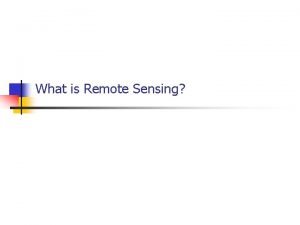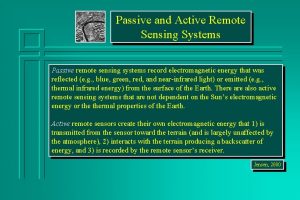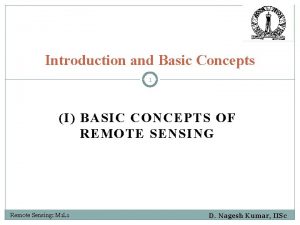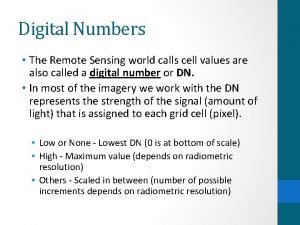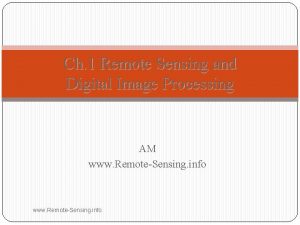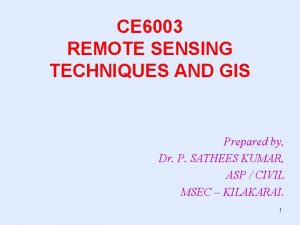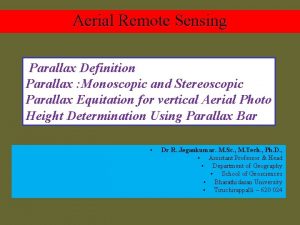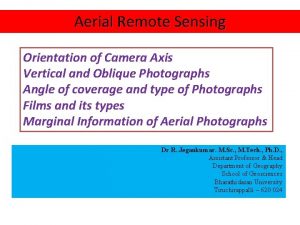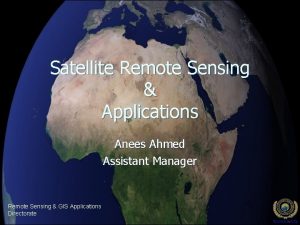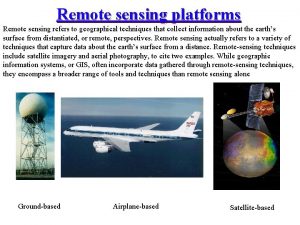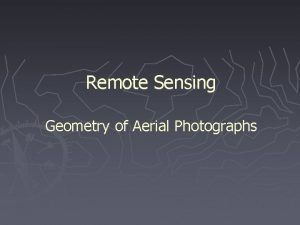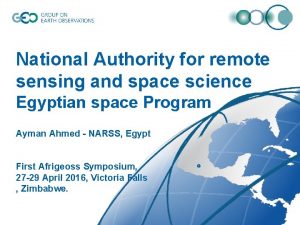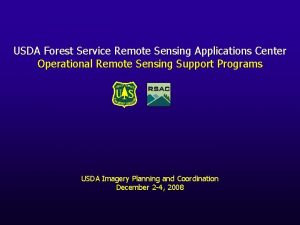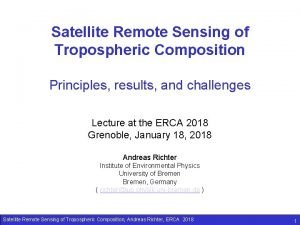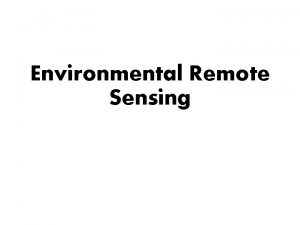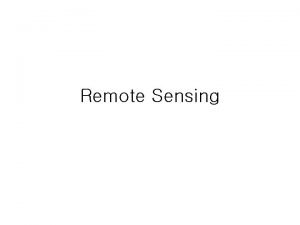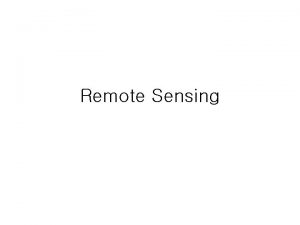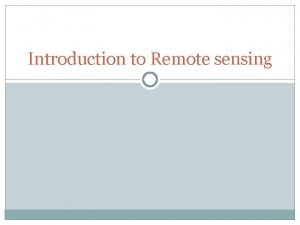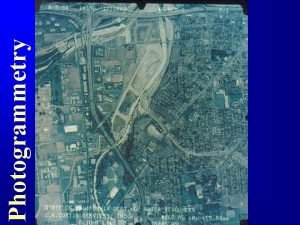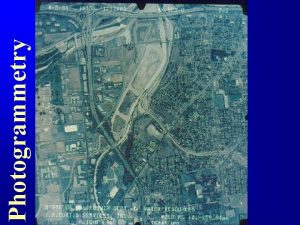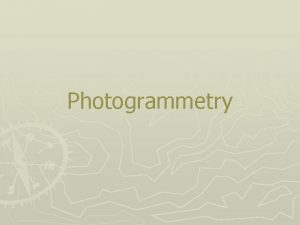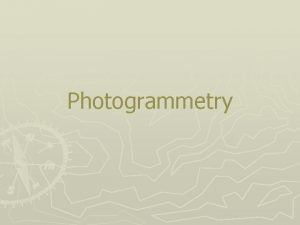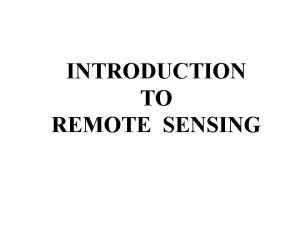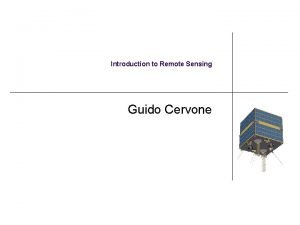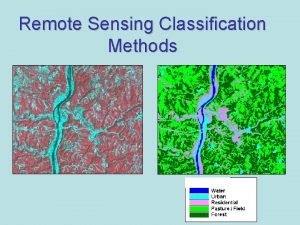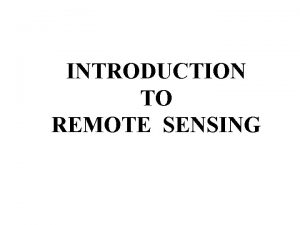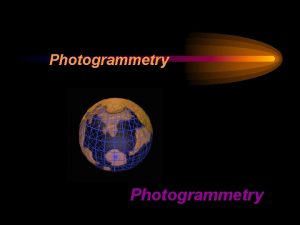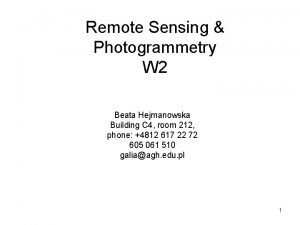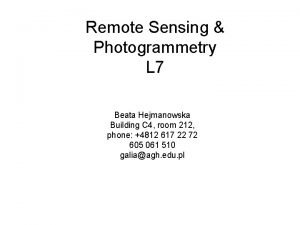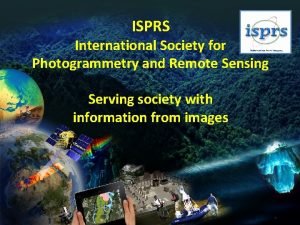Chapter 6 Photogrammetry Introduction to Remote Sensing Instructor




















- Slides: 20

Chapter 6 Photogrammetry Introduction to Remote Sensing Instructor: Dr. Cheng-Chien Liu Department of Earth Sciences National Cheng Kung University Last updated: 4 November 2004

Outline § Introduction § Basic principles • • Aerial photographs Photographic scale Area measurement Relief displacement(高差位移) Image parallax (影像視差) Ground control Mapping Flight planning

Introduction § Photogrammetry • Definition v. The science and technology of obtaining spatial measurements and other geometrically reliable derived products from photographs • Measurement v. Distance, area, elevations • Product v. Digital elevation models v. Orthophotos v. Thematic GIS data v. Other derived products § Approach of this book • Hardcopy softcopy • Aerial photos spaceborne images

Introduction (cont. ) § Subjects • Determining horizontal ground distances and angles from measurements made on a vertical photograph • Using area measurements made on a vertical photograph to determine the equivalent areas in a ground coordinate system • Quantifying the effects of relief displacement (高差移位) on vertical aerial photographs • Determination of object height from relief displacement measurement • Determination of object heights and terrain elevations by measurement of image parallax • Use of ground control points • Mapping with aerial photographs • Preparation of a flight plan to acquire aerial photography

Aerial photographs § Photogrammetry Vertical photographs • Unintentional tilts: <10 (<30) § Fig 3. 6 • • Basic geometric elements of a vertical photo L: the camera lens exposure station f: the lens focal length X-axis: the forward direction of flight Y-axix: 900 counterclockwise from the positive x-axis O: the ground principal point ABCDE abcde a’b’c’d’e’ The x y photocoordinates

Aerial photographs (cont. ) § Measurement of photocoordinates • Hardcopy v. Triangular engineer’s scale rudimentary problem Metric scale v. Glass scale built-in magnifying eyepieces v. Coordinate digitizer v. Comparator mono • Softcopy § Affine coordinate transformation § Source of error

Photographic scale § Photographic scale = map scale • Large scale small scale § Eq. 3. 1: S = d / D § Ex 3. 1 § Eq. 3. 2: S = f / H' § Fig 3. 7 § Eq. 3. 4: S = f / (H – h) § Ex 3. 2 § Eq. 3. 5: Savg = f / (H – havg)

Photographic scale (cont. ) § Vertical photo map • Perspective projection (透視投影) orthographic projection • Fig 3. 8 § Relief displacement

Area measurement § Accuracy • Measuring device • Image scale variation due to relief • Tilt in the photography § Simple way • Ex 3. 4 • Ex 3. 5 • Ex 3. 6

Relief displacement § Characteristics • Lean away from the center of the photograph • Fig 3. 12 § Correcting for relief displacement • Fig 3. 14(a). Displacement of terrain points • Fig 3. 14(b). Distortion of horizontal angles measured on photograph v Relief displacement Ø The datum plane: A΄B΄ a΄b΄ Ø Terrain points AB ab v a΄b΄: the accurate scaled horizontal length and orientation of the ground line AB. v Angle distortion: b΄c a΄ bca. Ø b΄oa΄= boa (no distortion) • Ex 3. 8

Image parallax § Characteristics • Principle: moving train viewing window relative movement distance • Fig 3. 15: Parallax displacements on overlapping vertical photographs. • Conjugate principal points the flight axis (Fig 3. 16) • Parallax: pa= xa-xa΄

Image parallax (cont. ) § Object height and ground coordinate location • Fig 3. 17 v Parallax relationships on overlapping vertical photos v Air base: B = L - L΄ • Parallax equation v Example 3. 9 v Difference in elevation § Parallax measurement • In example 3. 9 v Parallax 2 measurements required (cumbersome) • Fig 3. 18: single measurement parallax v Stereopair photographs fasten down with flight aligned p=x-x΄=D-d single measurement v a and a΄ are identifiable Ø Difficult to identify if the tone is uniform

Image parallax (cont. ) § Parallax measurement in hardcopy system • Fig 3. 19: floating-mark principle • Demonstration of stereoscope v Fig 3. 21: how to take readings • Ex 3. 10 § Parallax measurement in softcopy system • Image correlation • Fig 3. 22 v Reference window v Search window • Not constrained to the assumption of parallax equations • Collinearity equations v xyz XYZ (XL, YL, ZL) (w, f, k) v Aerotriangulation

Ground control § Ground control • Definition v. Refers to physical points on the ground whose ground positions are known with respect to some horizontal coordinate system and/or vertical datum • • • Horizontal Vertical GPS promising Accuracy is essential Cultural features, e. g. road intersection Ground survey artificial target premarked

Mapping § Stereoscopic plotting instruments • Photogrammetry topographic maps • Stereoplotters v Concept: Ø Stereopair photo: terrain ray lens image plane Ø Stereoplotter: photos ray terrain model 3 D view v Three components 1. A projection system 2. A viewing system 3. A measuring and tracing system v Fig 3. 23: a direct optical projection plotter Ø Image tracing table stereoview of terrain model Ø Relative orientation absolute orientation • Anaglyphic viewing system. v Color filter red, cyan v Only for panchromatic photo • Polarized platen viewer (PPV) v Polarizing filter • Stereo image alternator (SIA) v Rapidly alternate the projection of the two photos

Orthophotos § Orthophotos • • No scale, tile relief distortions Photomaps Best of both worlds Input to GIS Digital format § Generation analog orthophotos • Differential rectification • Orthophotoscopes • Orthophoto negative § Generation digital orthophotos

Coordinate transformations § 2 D conformal coordinate transformation • • • Scale change Rotation Translation Redundancy Matrix method § 3 D conformal coordinate transformation § 2 D projective coordinate transformation • Collinearity equation

Flight planning § Why need new photographs? • • Outdated Wrong season Inappropriate scale Unsuitable film type § Planning the flight • Weather clear weather beyond control v. Multi-task in a single clear day • Time 10 am~2 pm illumination max shadow min.

Flight planning (cont. ) § Planning the flight (cont. ) • Geometric aspects • • f Format size S Area size havg Overlap Side lap Ground speed § Example 3. 11 • • • H΄ Location, direction, number of flight lines Time interval Number of exposures Total number of exposures

Homework § Use your own digital camera to take a stereopair. Examine your stereopair using the stereoscope that we demonstrated in the classroom.
 Introduction to microwave remote sensing
Introduction to microwave remote sensing Energy transfer
Energy transfer Remote sensing platforms
Remote sensing platforms Active remote sensing
Active remote sensing Advantages of remote sensing
Advantages of remote sensing Digital number in remote sensing
Digital number in remote sensing Limitations of remote sensing
Limitations of remote sensing Idealized remote sensing system
Idealized remote sensing system Gis definition ap human geography
Gis definition ap human geography Choropleth map definition ap human geography
Choropleth map definition ap human geography Parallax in remote sensing
Parallax in remote sensing Strip camera in remote sensing
Strip camera in remote sensing Remote sensing image
Remote sensing image Ifov and fov in remote sensing
Ifov and fov in remote sensing Geometry of aerial photograph
Geometry of aerial photograph National authority for remote sensing and space sciences
National authority for remote sensing and space sciences Canada centre for remote sensing
Canada centre for remote sensing Ap human geography unit 1
Ap human geography unit 1 Remote sensing applications center
Remote sensing applications center Remote sensing applications center
Remote sensing applications center Remote sensing physics
Remote sensing physics

